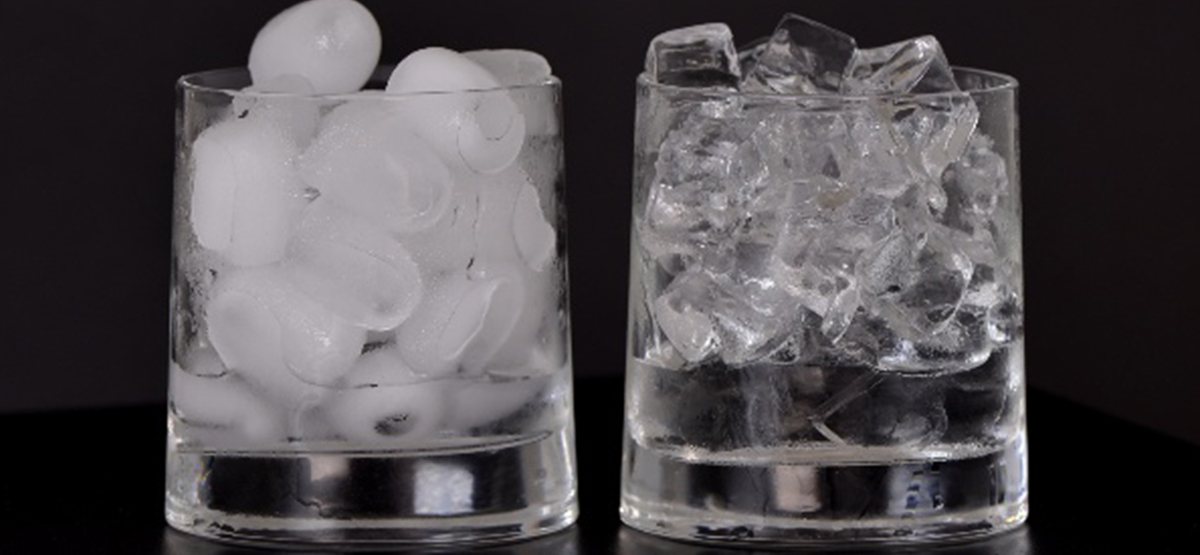You’re watching the game on TV with your family and friends, and at the break, someone suggests that icy drinks are required to challenge the heat. You walk into the kitchen, open the refrigerator and toss a few ice cubes into a jug of fresh lemonade. Hey, you might even have the ice dispensed through the closed freezer door.
Do you ever wonder how refrigerators make ice cubes?
Refrigerators have water pumps that have a line directly connected to the fridge. The ice tray is gradually filled with water. As the water freezes, it collects ice cubes into a bin, releasing them to the user when needed.
This occurs in the refrigerator’s cold section with some manufacturers, not the freezer. Samsung is one manufacturer that uses the refrigerant of the fridge, but in general, the freezer’s ambient temperature creates those globes of joy in your glass.
How A Refrigerator Ice Maker Works
Ever wonder how an ice maker works? The manual system whereby you fill a tray with water, etc., is straightforward and doesn’t tax the brain, and rather than reinvent the wheel, the icemaker has stuck to simplicity. The difference, of course, is the fact that it’s automated.
Like an assembly line, the unit produces cube after cube of perfectly shaped ice, using a thermometer and three other electrical components:
- The motor
- The heating unit, and
- The Water-valve (Not strictly electrical, but electrically controlled)
You hook these items up to the power source entering your refrigerator and connect a water line to the mainline for constant fresh water.
The icemaking cycle begins with a timed switch, which, in most units, sends a signal to a solenoid water valve, generally positioned behind the fridge. Current traveling down this route moves the solenoid, a coiled wire that opens the valve, allowing sufficient water to fill the mold.
The mold is generally a series of cavities, and each is joined to the next by a small slot, so each ice cube joins its neighbor. The ice mold itself will fill with water in just a few seconds and freeze in one to three hours.
Once the thermostat determines that the water is now ice, it activates the heating unit, which warms part of the tray, releasing the ice cubes.
The motor then spins a shaft that flips the ice cubes into a storage tray, where they wait patiently to be released through the ice dispenser in the door into your jug or glass.
A shut-off arm will check the ice level in the storage ice bin and prevent more ice production until the level drops and frees up sufficient space.
Is A Water Line Required To Make Ice?

It is possible to enjoy an automatic ice maker without having a water line, but the convenience of attaching one is compelling.
There is always the possibility that a water line springs a leak, and because you have connected them to a water pipe that’s always turned on, it is also possible that flood and resultant water damage could result.
Chances are not great of this occurring, but if your home is unpopulated for most of the day, you might not want to chance to return to a swamp in the evening.
Water damage is not a risk everyone is willing to take. Some refrigerators are produced with internal water tanks, which provide a leak-free alternative. This tank negates sacrificing the luxury of automatic ice production and still provides you with cold, clean water.
If you choose the more straightforward route of a water line connected to mains, ensure that a registered plumber assists you so that you at least have some recourse in the event of water damage.
How Refrigerators Make Ice Cubes
A fridge produces ice on demand, so the faster you consume the ice, the more often the fridge will create ice cubes. Production time is easily remembered as being in the region of one cube every ten minutes, though your fridge produces the entire tray at once.
We generally accept that you discard the first three or four batches of ice cubes produced by a new machine so that the lines that might still have factory grime in them are safely rinsed.
How Refrigerators Produce Crushed Ice
In truth, this ice is more like ice slivers than actual crushed ice, but if your fridge has this facility, it can help create beautiful mojitos on a hot summer’s day.
A storage area is situated below the ice storage bin, into which ice can be dropped. When you require crushed ice, the motor is powered, and the process begins. A shaft with chopping blades attached to it begins to rotate, trapping the ice between these blades and stationary blades fixed in the storage area.
Any ice cubes dropping into that container are trapped between the two sets of blades, shattering in about seven seconds. These slivers are what falls into your glass or cocktail shaker. That container is where the ice drops from when you push the ‘Crushed Ice’ button on your refrigerator door.
Why Is My Refrigerator Ice Cloudy?
You may have noticed that it is rarely cloudy when you get ice at a restaurant and clear ice is generally transparent. The reason is quite simple: It’s boiled before being frozen.

When the water temperature drops and the pouring water finally freezes, gas molecules are expelled, forming tiny bubbles trapped in the – now solid – water, making it opaque.
This gas expulsion is avoided by boiling the water before freezing, and the ice is as clear as your water source allows.
Naturally, this issue is moot if your refrigerator uses water piped in from the mains.
How Refrigerators Produce Crushed Ice
This ice in truth seems like the actual crushed ice, but when your fridge contains the capability, you can make gorgeous mojitos during warm Summer nights.
A storage unit lies beneath the freezer container to keep the ice in place when the snow falls. When you need crushed ice, the engine starts and the work starts. A shaft containing a cutter blade begins to rotate and traps the ice between the blades and stationary blades fixed in the compartment.
Almost everything that reaches this container is locked between two sets, which explodes immediately. These slivers fall out of your cocktail shakers.
Why Your Refrigerator Is Not Making Ice
Several issues might cause your otherwise perfect fridge to stop making enough ice now, and you quickly fix most, so don’t abandon hope just yet:
Ice Maker Is Jammed Or Broken
Check the ice machine unit for icing up and clear if this is the case. Commonly, the ice maker may be jammed with ice from the previous user.
The Water Filter Is Dirty
Clean the water filter regularly and replace it when you think it’s necessary. If your source is providing clean water, this is not going to be more than once a year or so
The Water Inlet Valve Is Clogged
Take a look and clean if you can access it. Caveat: On some units, you might need assistance from a professional to access this valve.
Check for ice cubes and slivers blocking up the assembly and remove them. The assembly unit might need replacing if it does not start to cycle when activated.
Frozen water line
In colder climes, this can occur. Unplug the refrigerator and find the offending line. Use a hair dryer and thaw the pipe carefully.
Seemingly obvious, please remember to re-plug the fridge in, or your food bill for the month might be ludicrous.
Conclusion
The system used by a refrigerator to create ice in a controlled manner is reasonably basic and should last many years if maintained.
Check the assembly at least once a month, and in the depth of summer, enjoy a mojito for me.
We’ve compiled a complete list of frequently asked kitchen questions for new and experienced homeowners.
Our team of experts answers these questions to help assist you through DIY projects and home repairs.

For over a decade, Robin has been a real estate agent, interior design specialist, and mother. Through her trials and tribulations, she wanted to create the perfect website to help you save money and make your home look beautiful.

Comments are closed.